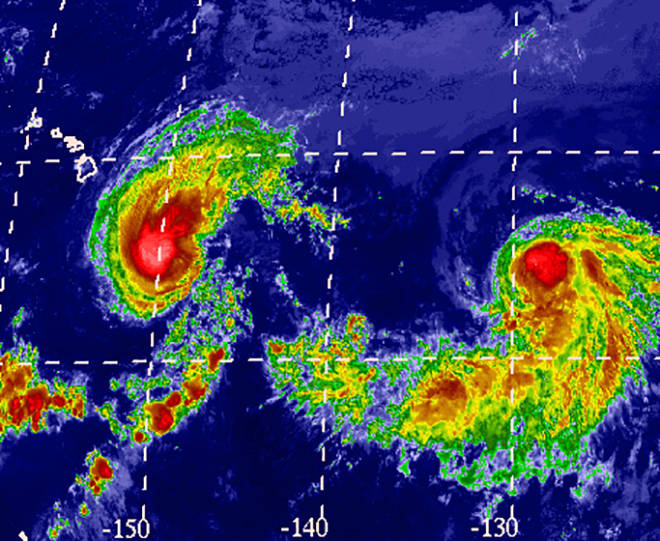Saturday marks the official end of the 2019 hurricane season, which saw five tropical cyclones — but only one attaining hurricane strength — in the Central Pacific basin, which extends from 140 degrees west to the International Date Line and includes Hawaii.
“It was quieter than last year, and it was quieter than we expected going into this year,” said John Bravender, warning coordination meteorologist at the National Weather Service’s Honolulu office, on Tuesday, after the National Oceanic and Atmospheric Administration, the weather service’s parent agency, issued its 2019 Central Pacific hurricane season summary.
NOAA’s 2019 hurricane season outlook issued on May 22 called for five to eight tropical cyclones in the Central Pacific basin — with a 70% chance of above-normal tropical cyclone activity, a 20% chance of near-normal activity and a 10% chance of below-normal activity.
The 2019 season started with an El Nino event that was expected to last through the fall. Instead, steady cooling in equatorial waters commenced early in the summer, leading to neutral conditions by the heart of the hurricane season.
“With the switch from El Nino to neutral conditions, we ended up having not as much activity as we expected,” Bravender said.
Four to five tropical cyclones occur during a normal year.
Hurricane Erick, the first named storm of the season, moved into the basin from the east on July 30. Erick rapidly intensified to a Category 4 hurricane with maximum winds of 130 mph, but steadily weakened as it passed south of the main Hawaiian Islands.
Tropical Storm Flossie entered the basin Aug. 3 and approached Hawaii from the east, eventually dissipating before reaching the islands.
Tropical Depression 12-E entered the basin Sept. 4 and strengthened to Tropical Storm Akoni.
And Tropical Storm Ema developed southwest of the main Hawaiian Islands on Oct. 12, and dissipated over the southern portion of the Papahanaumokuakea Marine National Monument shortly before crossing between French Frigate Shoals and Maro Reef.
As far as impacts to Hawaii, swells from Hurricane Barbara, which dissipated just before crossing into the Central Pacific, caused high surf along east-facing shores statewide from July 6-9. Remnant moisture from Barbara also led to heavy rain throughout Maui and the Big Island from July 8-11.
Swells generated by Erick and Flossie led to high surf along east- and south-facing shores during Aug. 1-6. Erick also contributed to heavy rain over Hawaii County on Aug. 2, and around Kauai from Aug. 4-5.
Those impacts, while noticeable, are relatively insignificant when compared to Hurricanes Lane and Olivia in 2018 — a year in which four of six Central Pacific cyclones were major hurricanes packing sustained winds of at least 120 mph.
Lane was a former tropical cyclone that already passed the Big Island and was being reduced to remnants by wind shear when the storm’s outer rain bands dropped a deluge of historic proportions on East Hawaii in late August 2018.
The National Weather Service described the downpour — which damaged numerous homes and businesses, destroyed two homes in Hawaiian Acres subdivision and caused evacuations in Reed’s Island in Hilo and Keaau Ag Lots — as the “third highest storm total rainfall from a tropical cyclone in the United States since 1950.”
Mountain View received 51.53 inches of rain between noon Aug. 22, 2018, and 4 a.m. Aug. 26, 2018.
Damage to county facilities totaled about $20 million, and an estimated 152 homes were damaged, with 59 sustaining major damage from Lane, Managing Director Wil Okabe said last year.
Olivia entered the Central Pacific on Sept. 8, 2018, as a Category 1 hurricane. As Olivia approached the islands, tropical storm watches were issued statewide, and on Sept. 12, Olivia made landfall as a tropical storm over West Maui and Lanai, packing heavy rain and high winds.
“We’re very happy that we escaped significant impact this season,” Bravender said. “Last year, we had Olivia making landfall twice, and Lane — without even making landfall — caused significant damage, significant impacts. We are happy when we escape that, but we also want people to realize that luck isn’t going to hold out. We don’t want people thinking we’re going to be safe because we’re a small target in the big ocean.”
Email John Burnett at jburnett@hawaiitribune-herald.com.






